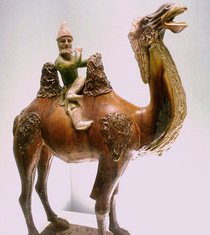
Chinese History 101 #04: Mid Imperial China
Last updated: Saturday July 24th, 2021
Report this blog
From where we left off
In the previous blog, I stopped the end of the Northern and Southern dynasties in 589 AD (the grey section). This blog starts from the Sui dynasty which reunified China after 400 years of separation (the golden section).
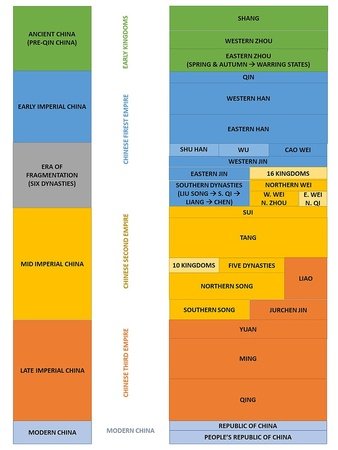
Sui Dynasty (581 - 618 AD)
Yang Jian, an ethnic Han Chinese, rose to power quickly in the Northern Zhou court, with his daughter married to the emperor. He became the regent, dictating both politics and military of the Northern Zhou and eliminated opposing princes. Within 10 months, he usurped the throne and established the Sui dynasty in 581.
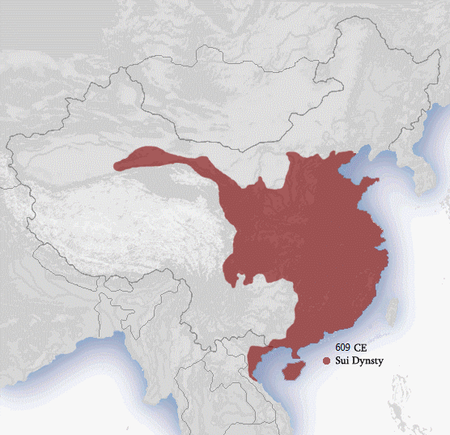
After the reunification, the Sui dynasty enjoyed a brief period of prosperity. However, the dynasty declined quickly after engaging in costly and disastrous military campaigns against Goguryeo (Korea). In addition, under Emperor Yang, heavy taxes and millions of forced labour were put into building mega projects such as the Grand Canal which connected the capital Chang'an to Hangzhou and Beijing, partly because the emperor enjoyed travelling on a lavish river cruise to the East. Massive uprising occurred across the country and the Sui dynasty was soon replaced by the Tang dynasty.
The Sui dynasty only lasted 37 years, but it made significant impacts and is often compared to the Qin dynasty for reunifying China, its short reign and laying the foundation for the next dynasty to come.
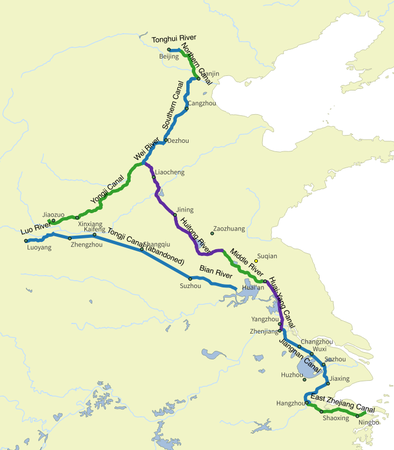
Tang Dynasty (618 - 907 AD)
Li Yuan was a duke based in Taiyuan, and was the first-cousin of Emperor Yang. Li Yuan rose in rebellion in 617, along with his son and his equally militant daughter Princess Pingyang, who raised and commanded her own troops. In winter 617, Li Yuan occupied the capital Chang'an. Meanwhile, Emperor Yang was staying in a luxurious palace in Jiangdu (today Yangzhou) in a decadent lifestyle, with hundred of beautiful women and drinking everyday. He realised his fall was near but did not want to hear about it. On one occasion, when he was looking in the mirror, he told his empress, "I have a good neck, and I'm waiting for someone to sever it."
He did get his wish and was murdered by one of the rebels in 618. On the news of Emperor Yang's death, Li Yuan declared himself the emperor of a new dynasty, the Tang, and he was known as Emperor Gaozu.
With the help of his second son Li Shimin, Emperor Gaozu defeated all other rebels and unified the country. In a palace coup in 626, Li Shimin killed his elder brother (the crown prince) and younger brother, and 60 days later Emperor Gaozu abdicated and passed the throne to him, who was known as Emperor Taizu.
Although responsible for killing his brothers and deposing his father, Emperor Taizu was a capable leader who listened to the advice of the wisest members of his council and encouraged criticisms of him. He exercised thrift and the country recovered from the brutal regime of the Sui, and the economy flourished. Militarily, he defeated the Eastern Turks and dominated power in Central Asia, and subsequently took the title of "Khan of Heaven". His 23 year reign was the golden era in Chinese history and he is often considered the greatest emperor of all time.
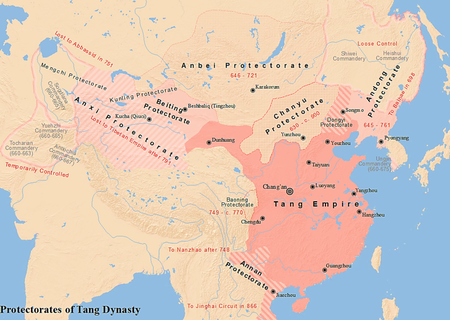
After Emperor Taizu, the Tang continued its expansion under Emperor Gaozong. It annexed the Western Turks and reached its largest extent. When Emperor Gaozong suffered a stroke in 660, the court administration went to his empress Wu Zetian. A strong, charismatic, cunning, vengeful, ambitious and well-educated woman, Empress Wu was the most powerful and influential woman at court during a period when the Tang dynasty was in its glorious days. In 690, Empress Wu decided to seize the throne from her two sons, proclaiming the Zhou dynasty and became the only legitimate female monarch in Chinese history.

Under her 40-year reign, China grew larger, corruption in the court was reduced, its culture and economy were revitalized, and it was recognised as one of the greatest power of the world.
In 705, her son resumed power in a coup when Wu was seriously ill. The Tang dynasty was restored and Wu passed away soon after. After her reign, other empress and princesses tried to replicate Wu's reign but failed, and the throne subsequently passed onto Wu Zetian's grandson, Emperor Xuanzong.
The 44-year reign of Emperor Xuanzong were split into the Kaiyuan (713-741) and Tianbao (742-756) eras. During the Kaiyuan era, the Tang dynasty reached its peak, with a period of political stability, peace in society, and economic prosperity, as well as advances in education, arts, and religion.
However, by the time of Tianbao, Emperor Xuanzong turned his attention to pleasure-seeking with his favourite concubine Yang Guifei, and much of his power fell into the hands of the Lady Yang's dissolute cousin Yang Guozhong and the corrupt eunuch Gao Lishi. In 751, the Tang dynasty lost to an allied force from the Abbasid Caliphate and the Tibetan Empire at the Battle of Talas. The defeat marked the end of Tang westward expansion and tipped the balance of power in Central Asia towards the Muslims. The Abbasids benefitted economically by controlling the Silk Road, and papermaking technology was passed from Chinese prisoners to the Middle East and later Europe.
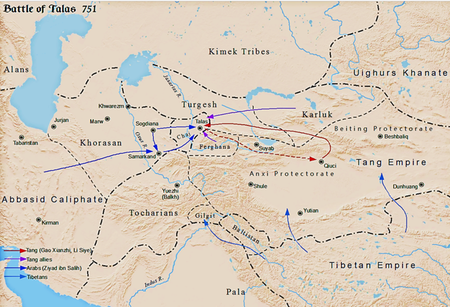
The end of Emperor Xuanzong reign came when An Lushan, a general from the Northeast, rebelled and his army invaded Luoyang and Chang'an in 755. Emperor Xuanzong fled the capital but his soldiers refused to follow him until he reluctantly killed Yang Guifei. The love story between Emperor Xuanzong and Yang Guifei was retold in the "Song of Everlasting Regret", an epic poem written in 809 by Bai Juyi. You can find the English translation here.
The An Lushan Rebellion lasted for 8 years and greatly weakened the Tang dynasty. It is sometimes considered one of the deadliest conflicts in human history, with possibly ten of millions killed. The Tang dynasty lost control of vast territory including Central Asia. Regional military governors were set up and granted to those who helped defeat the rebels, or even to those who rebelled but later pardoned. They had autonomous powers and little control from the central government. Both Chang'an and Luoyang were heavily damaged and the political centre of China started shifting to the East.
In the 9th century, the Tang dynasty experienced a brief period of revival during the reign of Emperor Xianzong (805-820), but the subsequent emperors were less capable and the dynasty went into further decline. The country fell into chaos during the Huang Chao Rebellion (874-884), when Chang'an was invaded again and it took 10 years to suppress. The Tang dynasty ended when the military governors declared independence.
Although the history of the later half of the Tang dynasty was turbulent and dysfunctional, the Tang dynasty is still generally regarded as the high point in Chinese civilisation that rivalled the Han. Today, the Chinese diasporas call themselves "Tang people", and Chinatowns around the world are called "Tang people street" in Chinese.
Five Dynasties and Ten Kingdoms (907 - 960 AD)
The period consisted of five short-lived dynasties in central China, as well as 10 kingdoms in southern China (except one in the north). The Five Dynasties and Ten Kingdoms period was considered a continuation of the late Tang period where the country was ruled by de-facto independent warlords. The 5 dynasties shared their names with previous ones and historian prefixed them with the word "later".
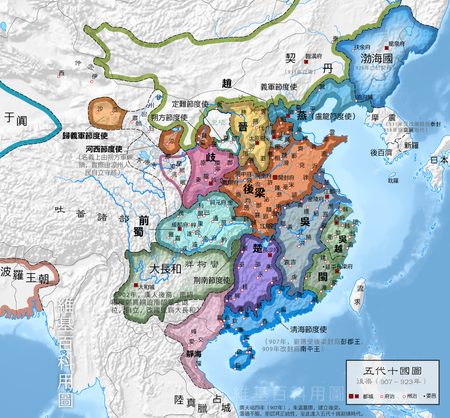


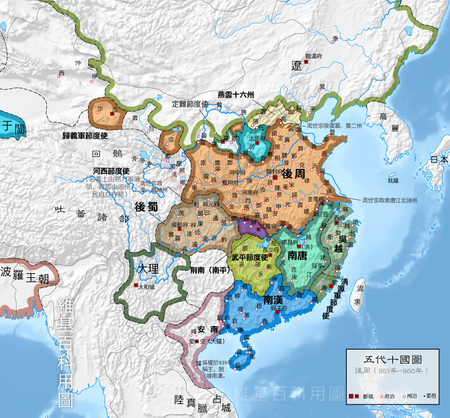
During that time, the Khitans, a para-Mongolic nomadic people from Northeast Asia, established the Khitan Empire (and later called the Liao dynasty) in 916 in northern China and Mongolia. In 936, the third of the Five Dynasties overthrew the second one with aid from the Khitans, and in return ceded the Sixteen Prefectures, including Beijing, to the Khitans in 938. Although three of the 16 prefectures were later recovered, the Han Chinese would lose control of Beijing and the North for the next 430 years.
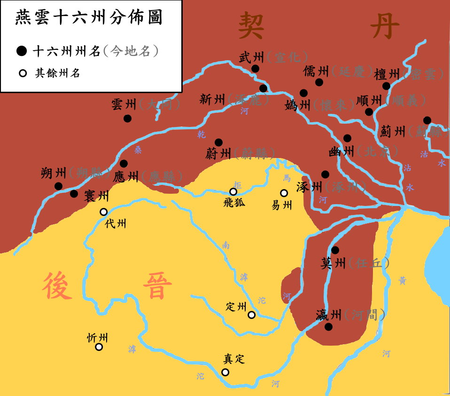
The end of the fourth blog
I decided that the third blog was too long and overwhelming, so I stop here before going on to the next dynasty. I plagiarised referenced a lot from the Wikipedia articles. If you want to learn more about any of these, you can read the links or ask me questions in the comment. Otherwise, you can search for movies such as the Detective Dee series which was based on Empress Wu era. Thank you for reading my blog.
